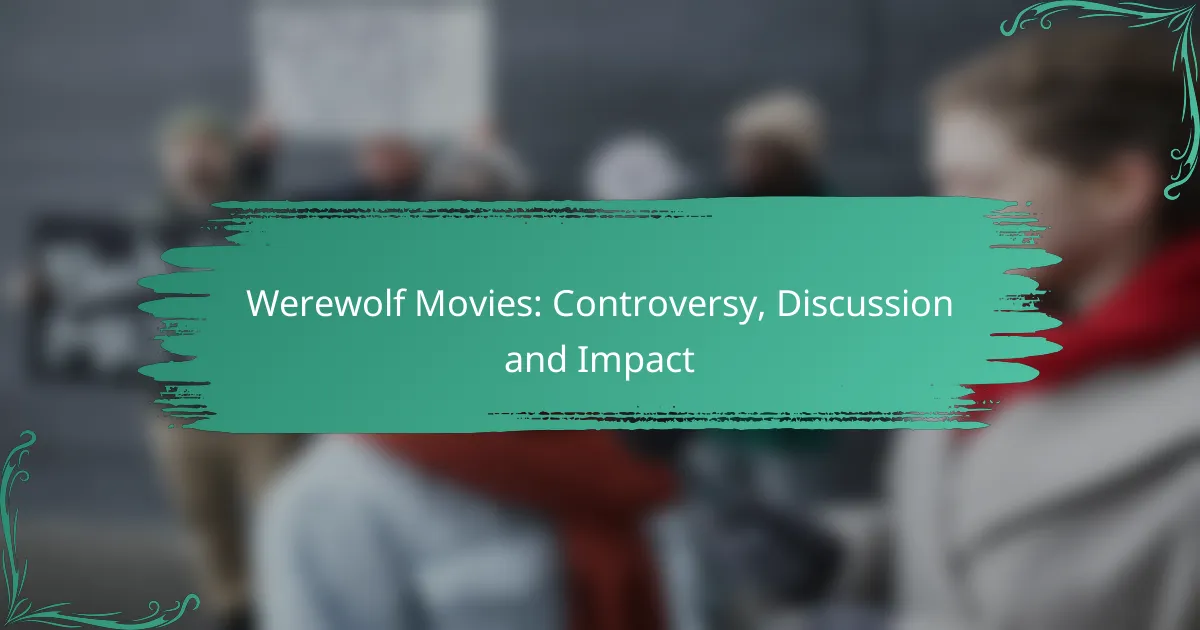Werewolf movies have captivated audiences by merging horror, fantasy, and sometimes comedy, with iconic films like “American Werewolf in London” and “Ginger Snaps” shaping the genre’s evolution. However, these films often ignite discussions surrounding their portrayal of violence, gender stereotypes, and cultural appropriation, influencing both audience perceptions and the broader discourse in horror and fantasy. Their impact extends beyond cinema, leaving a lasting imprint on popular culture and various media forms.
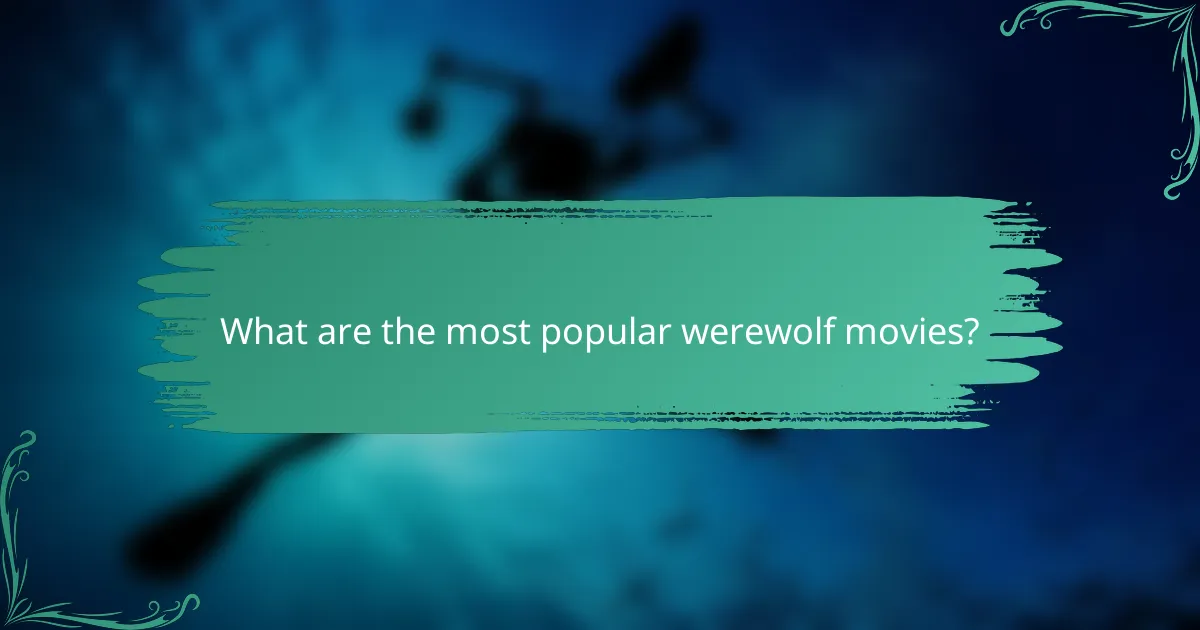
What are the most popular werewolf movies?
The most popular werewolf movies often blend horror, fantasy, and sometimes comedy, showcasing the transformation and struggles of their characters. Iconic films like “American Werewolf in London” and “Ginger Snaps” have left a significant mark on the genre, influencing both storytelling and visual effects.
American Werewolf in London
“American Werewolf in London,” directed by John Landis, is a landmark film in the werewolf genre, known for its groundbreaking special effects and dark humor. The story follows two American backpackers who encounter a werewolf while traveling in England, leading to a transformation that changes one of their lives forever.
The film is celebrated for its transformation scene, which set a new standard for practical effects in horror cinema. Its blend of horror and comedy has influenced many subsequent films, making it a must-watch for fans of the genre.
Dog Soldiers
“Dog Soldiers,” directed by Neil Marshall, combines military action with horror, featuring a group of soldiers who encounter werewolves during a training exercise in the Scottish Highlands. The film is notable for its intense atmosphere and practical effects, creating a gripping survival story.
This film stands out for its character development and camaraderie among the soldiers, which adds depth to the horror elements. Its cult following has solidified its status as a modern classic in the werewolf film category.
Ginger Snaps
“Ginger Snaps” is a unique take on the werewolf mythos, focusing on the struggles of two teenage sisters as one of them undergoes a transformation into a werewolf. The film cleverly uses the werewolf metaphor to explore themes of puberty, identity, and the bond between siblings.
The film’s blend of horror and coming-of-age elements has resonated with audiences, making it a significant entry in the genre. Its feminist perspective and character-driven narrative set it apart from traditional werewolf films.
Underworld Series
The “Underworld” series presents a modern interpretation of the werewolf myth, depicting a war between vampires and lycans (werewolves). The films are known for their stylish action sequences and complex lore, appealing to fans of both horror and fantasy.
While the series primarily focuses on vampires, the portrayal of werewolves as formidable adversaries adds depth to the storyline. The franchise has garnered a dedicated fanbase, contributing to its longevity in popular culture.
Wolfman (2010)
“Wolfman,” a remake of the classic 1941 film, stars Benicio del Toro as the titular character who transforms into a werewolf after being bitten. The film aims to capture the gothic horror aesthetic of the original while incorporating modern special effects.
Despite mixed reviews, “Wolfman” is notable for its atmospheric visuals and strong performances, particularly by del Toro and Anthony Hopkins. It serves as a reminder of the enduring appeal of werewolf stories in cinema, blending tradition with contemporary filmmaking techniques.

What controversies surround werewolf movies?
Werewolf movies often spark debates due to their portrayal of violence, reinforcement of gender stereotypes, and instances of cultural appropriation. These controversies can impact audience perceptions and influence the broader discourse around horror and fantasy genres.
Portrayal of violence
The depiction of violence in werewolf films frequently raises concerns about glorifying aggression and brutality. Many films showcase graphic transformations and violent encounters, which can desensitize viewers to real-world violence. Critics argue that such portrayals may contribute to a culture that normalizes aggression, particularly among younger audiences.
When analyzing these films, consider the balance between horror and responsible storytelling. Filmmakers should be mindful of how violence is depicted and its potential effects on viewers. A focus on character development and emotional stakes can provide depth without resorting to excessive violence.
Gender stereotypes
Gender representation in werewolf movies often leans heavily on traditional stereotypes, with female characters frequently portrayed as victims or love interests. This can reinforce outdated notions of femininity and masculinity, limiting the roles available to women in the genre. Male characters, on the other hand, are often depicted as strong and dominant, further entrenching gender norms.
To counteract these stereotypes, filmmakers can create more nuanced characters that defy traditional roles. Strong female leads who are active participants in the narrative can provide a more balanced perspective and resonate with diverse audiences.
Cultural appropriation
Cultural appropriation is another significant issue in werewolf films, particularly when filmmakers draw on folklore and traditions from cultures without proper representation or understanding. This can lead to misrepresentation and a lack of respect for the original cultural contexts, alienating audiences and perpetuating harmful stereotypes.
To avoid cultural appropriation, filmmakers should engage with cultural consultants and prioritize authentic storytelling. Respecting the source material and giving voice to those from the culture being represented can lead to richer narratives and a more inclusive film landscape.
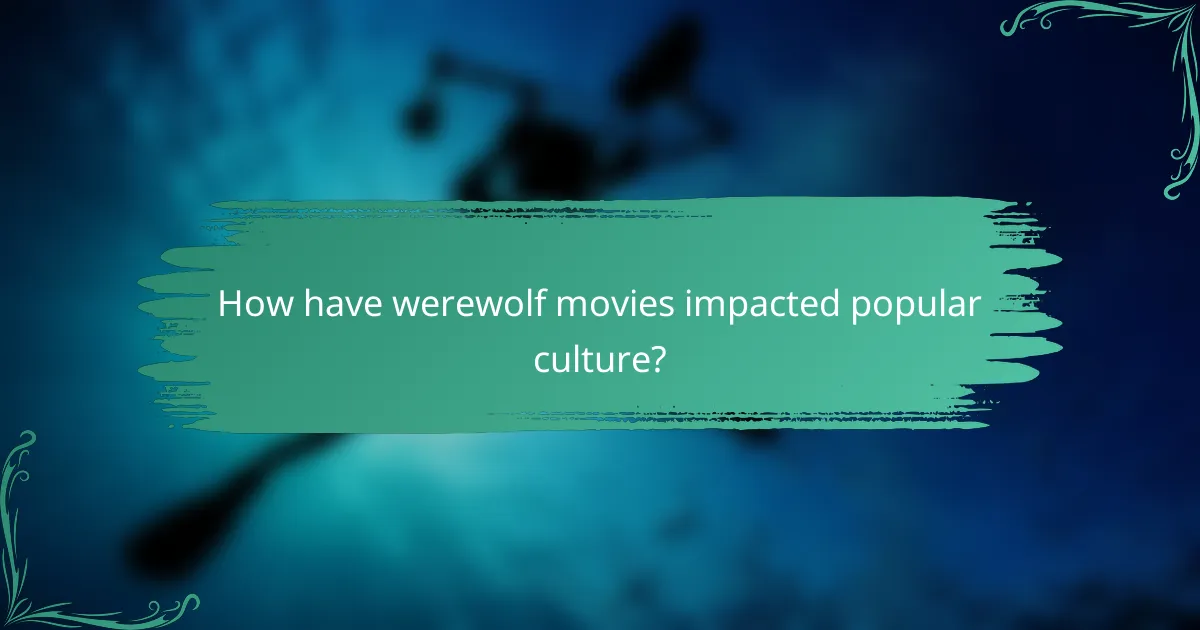
How have werewolf movies impacted popular culture?
Werewolf movies have significantly influenced popular culture by shaping perceptions of the supernatural and horror elements in storytelling. Their unique blend of folklore and cinematic creativity has left a lasting mark on various media, from films to merchandise.
Influence on horror genre
Werewolf movies have played a crucial role in the evolution of the horror genre, introducing themes of transformation, identity, and the duality of human nature. Classic films like “The Wolf Man” set the standard for how werewolves are portrayed, often emphasizing the tragic aspects of their condition.
Modern interpretations continue to explore these themes, blending horror with other genres such as romance and comedy. This versatility has allowed werewolf narratives to remain relevant, appealing to diverse audiences and inspiring countless filmmakers.
Merchandising and fandom
The popularity of werewolf films has led to a thriving market for related merchandise, including action figures, clothing, and collectibles. Fans often engage with these products, creating a vibrant community that celebrates their favorite characters and stories.
Conventions and fan events frequently feature werewolf-themed activities, fostering a sense of belonging among enthusiasts. This merchandising not only boosts the film industry but also strengthens the cultural footprint of werewolf lore.
Impact on folklore
Werewolf movies have revitalized interest in traditional folklore, bringing ancient myths into contemporary discussions. By adapting these stories for modern audiences, filmmakers have sparked curiosity about the origins and variations of werewolf legends across different cultures.
This renewed focus on folklore has led to a broader appreciation for the narratives that shape societal fears and beliefs. As a result, werewolves have become a symbol of the struggle between civilization and primal instincts, resonating deeply with audiences worldwide.

What themes are commonly explored in werewolf films?
Werewolf films often explore themes of transformation, identity, and the struggle between human nature and primal instincts. These narratives delve into the psychological and social implications of becoming a werewolf, reflecting deeper human fears and desires.
Transformation and identity
Transformation is a central theme in werewolf films, representing both physical change and psychological turmoil. The shift from human to beast often symbolizes a loss of control and the struggle to maintain one’s identity amidst overwhelming urges. This theme resonates with audiences, as it mirrors personal experiences of change and self-discovery.
For instance, characters may grapple with their dual nature, leading to conflicts that highlight the tension between their human selves and the beast within. This internal battle can serve as a metaphor for broader issues such as addiction, mental health, or societal expectations.
Human versus beast
The conflict between human and beast is a recurring motif in werewolf narratives, illustrating the struggle between civility and primal instincts. This theme raises questions about morality, ethics, and the nature of humanity itself. Characters often face dilemmas that force them to confront their darker sides, leading to dramatic consequences.
In many films, this theme is explored through the lens of societal norms, where the werewolf represents the repressed desires that society deems unacceptable. The tension between these two aspects can create compelling narratives that challenge viewers to reflect on their own instincts and societal roles.
Isolation and community
Isolation is a prevalent theme in werewolf films, often depicted through the protagonist’s struggle to connect with others after their transformation. The fear of being shunned or misunderstood can lead to a profound sense of loneliness, emphasizing the emotional toll of their condition. This theme highlights the importance of community and acceptance in the face of adversity.
Conversely, some narratives explore the idea of community among werewolves, where characters find solace and understanding in their shared experiences. This duality showcases the complexities of belonging and the human need for connection, even in the most challenging circumstances.
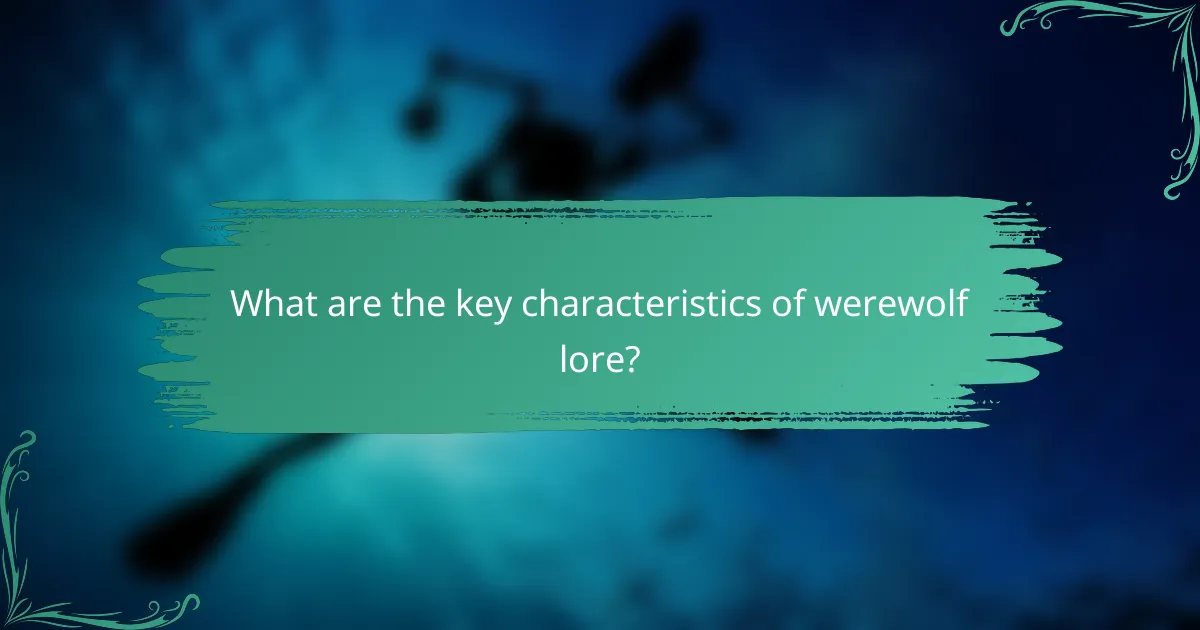
What are the key characteristics of werewolf lore?
Werewolf lore typically includes themes of transformation, vulnerability to silver, and mythological origins. These elements create a rich narrative that has evolved across cultures and time periods.
Mythological origins
The origins of werewolf mythology can be traced back to ancient civilizations, including Greek and Roman cultures. Stories often depict humans transforming into wolves due to curses, divine punishment, or magical rituals.
In Norse mythology, the tale of the berserkers illustrates warriors who could shift into wolf forms during battle, embodying ferocity and strength. This connection between humans and wolves has persisted in various cultures, influencing modern interpretations.
Physical transformations
Physical transformations in werewolf lore are often depicted as painful and dramatic, usually occurring during a full moon. The transformation process may involve changes in body size, fur growth, and heightened senses.
In films and literature, these transformations are frequently portrayed with special effects that emphasize the horror and intensity of the change. The visual representation can vary widely, from subtle shifts to grotesque metamorphoses.
Silver bullet vulnerability
The concept of silver bullets as a means to kill werewolves is a defining characteristic of the lore. This vulnerability is often attributed to silver’s purity and its historical associations with protection against evil.
In practical terms, the idea of using silver bullets has become a popular trope in werewolf films and stories, symbolizing the struggle between good and evil. While this is a fictional element, it has cemented itself in popular culture, influencing how werewolves are portrayed in various media.
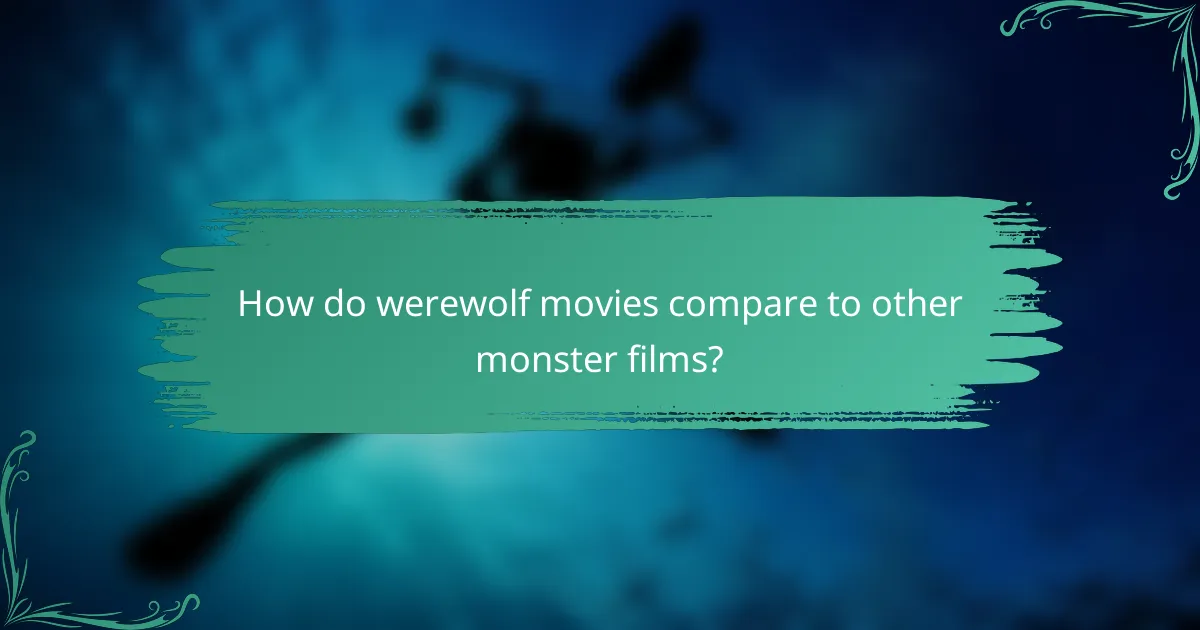
How do werewolf movies compare to other monster films?
Werewolf movies stand out among monster films due to their unique blend of horror, folklore, and psychological transformation. Unlike traditional monsters, werewolves often embody the struggle between humanity and primal instincts, creating a rich narrative depth that resonates with audiences.
Unique Themes and Motifs
Werewolf films frequently explore themes of duality, identity, and the loss of control. The transformation from human to beast symbolizes inner turmoil and societal fears, making these films particularly compelling. In contrast, other monster films may focus more on external threats or pure horror without delving into the psychological aspects.
Character Development
Character arcs in werewolf movies often emphasize the internal conflict of the protagonist. Unlike many other monster films where characters may serve as mere victims or heroes, werewolf narratives typically showcase a journey of self-discovery and moral ambiguity. This depth allows for more complex storytelling and character engagement.
Cultural Impact and Legacy
The cultural impact of werewolf films is significant, influencing various genres and media. Classic films like “The Wolf Man” have paved the way for modern interpretations, while the werewolf mythos continues to inspire literature, television, and video games. This enduring legacy highlights the werewolf’s role as a metaphor for human nature and societal fears, distinguishing it from other monster archetypes.
